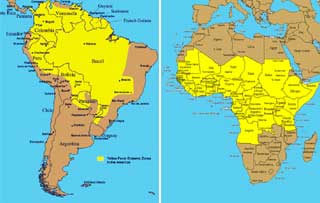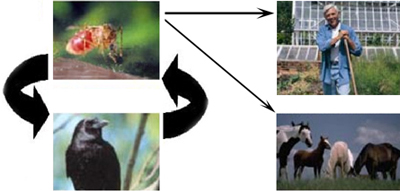Other Mosquito-Borne Diseases
Mosquitoes carry other diseases that affect people, although none quite so widespread and devastating as malaria. The same mosquito-control techniques apply for these illnesses: spraying indoor walls with insecticide, regularly using mosquito repellent, wearing protective clothing, putting screens in windows, sleeping under pesticide-treated bed nets, and eliminating standing water so mosquitoes can’t breed.
Dengue Fever
Each year more than 100 million people get dengue (pronounced DENG-gee) fever, or the related illnesses dengue hemorrhagic fever and dengue shock syndrome. Four closely related viruses, called DEN-1, 2, 3, and 4, cause this illness. The main carriers of the virus are two mosquito species: Aedes aegypti and A. albopictus. These mosquitoes occur mostly in urban and semiurban areas in the tropical and subtropical regions around the world. Dengue can crop up almost anywhere: Hawaii coped with an outbreak in 2001. Although all four viruses are closely related, exposure to or infection with one does not provide immunity to the others. However, a person can get each type only once. Research for a dengue fever vaccine is in progress.
|
Photo courtesy of CDC.
|
Dengue symptoms appear about five to six days after the person is bitten by an infected mosquito. Symptoms include a high fever, severe headache, pain behind the eyes, joint and muscle pain, and nausea and vomiting. Three to four days after the fever starts, a rash appears. The joint and muscle pain can be particularly notable; in fact this disease used to be called bone break fever because of the pain. These symptoms are identical to those for malaria. Because of that, a diagnosis of malaria should be eliminated before treatment for dengue, because malaria can be rapidly fatal, and dengue is not. Blood tests taken two to three weeks apart confirm the diagnosis. Treatment for dengue fever includes bed rest, fluids, and acetaminophen to reduce fever. Recovery takes about two weeks.
Some dengue outbreaks take the form of the more serious dengue hemorrhagic fever. The patient bleeds from the nose, gums, or under the skin, and suffers damage to blood and lymph vessels. Dengue hemorrhagic fever can cause death and should be treated in the hospital. In rare cases the illness takes its most severe form, dengue shock syndrome. The patient suffers from very low blood pressure and massive bleeding. Dengue shock syndrome can also be fatal and must be treated in the hospital.
Yellow Fever
|
Photo courtesy of CDC. Yellow fever commonly occurs in central Africa and Central and South America. |
Yellow fever, another mosquito-borne virus, occurs in Africa and Central and South America. The virus incubates for 3 to 6 days. The infected person then develops a fever, muscle pain with backache, headache, shivers, loss of appetite, and nausea and vomiting. After 3 to 4 days most patients get better. However, up to 15% develop a more serious version, called the toxic phase. The fever returns, and the patient suffers from jaundice, abdominal pain with vomiting, and bleeding from the eyes, nose, mouth, and stomach. Blood also appears in the urine and feces. Kidney function decreases, and complete kidney failure can occur. Half of the patients with toxic phase die in 10 to 14 days; the rest fully recover. Yellow fever can be difficult to identify because its symptoms mimic those of so many other illnesses, including malaria, and dengue fever. A blood test confirms the yellow fever diagnosis. Treatment of yellow fever focuses on keeping the patient comfortable.
Unlike many other mosquito-borne illnesses, yellow fever can be prevented with a very effective vaccine. The vaccine can be given to infants as well as adults. Protection from the vaccine lasts for 10 years. Because of lack of good health care in many of the regions where this illness occurs, it is once again on the rise.
West Nile Virus
|
Photo courtesy of CDC. The West Nile virus primarily moves between birds and mosquitoes. Horses and humans get the disease from mosquito bites but are not the main hosts. |
The West Nile virus, another mosquito-transmitted illness, is closely related to the St. Louis encephalitis virus. It occurs around the world in temperate and tropical climates. For many years the range of this illness was confined to southwestern Asia, the Middle East, southern and middle Europe, and Africa. However, in 1999 the West Nile virus appeared in the United States. In the years since, it has spread across the country and into Canada. Researchers are working on a vaccine.
Most people do not get sick from the West Nile virus. Some people develop a moderate flu-like illness with fever, headache, body aches, nausea and vomiting, and in some cases swollen lymph glands or a body rash. This lasts a few days. The West Nile virus can cause serious complications in people with weak immune systems, including very young babies and elderly people. The symptoms include high fever, headache, stiff neck, disorientation, coma, tremors, convulsions, numbness, and paralysis. This lasts for several weeks and may leave permanent neurological damage or cause death. The West Nile virus affects horses and birds, and an unusual number of dead birds in a region indicates the presence of this virus there.
This content has been re-published with permission from SEED. Copyright © 2025 Schlumberger Excellence in Education Development (SEED), Inc.



 Area with Aedes Aegypti and dengue epidemic activity
Area with Aedes Aegypti and dengue epidemic activity
